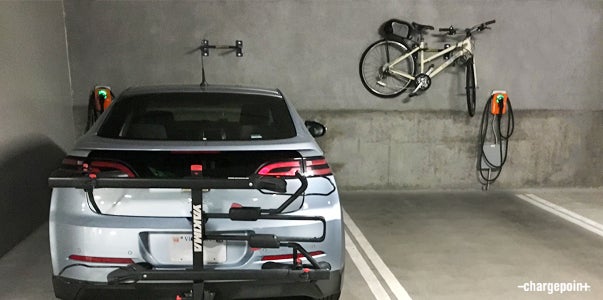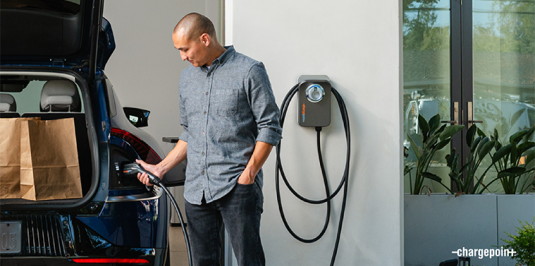
Home is the most convenient place to charge an electric vehicle: just plug in after work and in the morning your EV is charged and ready to go. Single-family home owners who drive electric can just decide to install charging in their garage, but charging at home can be tricky if you live in a condo and have to get approval from your HOA or condo board to charge.
At ChargePoint, we hear from many current and prospective EV drivers who live in condos and want to be able to get an EV and charge at home. Though we don’t yet have a magic wand we can wave to get approval, my team has drawn on hundreds of conversations with drivers in your position and their community managers to come up with three simple tips that will make it easy for your HOA or condo board to say “yes!” to your EV charging request.
1. Engage Your HOA Early
Even though you own your parking spot, you don’t own your property’s electrical infrastructure. To install charging, you’ll likely need to run wiring along common walls from a shared electrical panel. Your HOA may require you to put in a formal request to your architectural committee or form a committee to research and make a recommendation on how to implement EV charging. You can help shape this conversation from the start with a simple, cost-effective plan.
2. Survey Your Neighbors
Survey your neighbors to see who else is interested in getting an electric car. It’s much easier to get your condo board to approve EV charging when many people show interest. Access to charging at home or work greatly increases the likelihood that someone will choose to drive electric, and you can even pitch EV charging as a way to attract new residents to your community. If there are not a lot of people with EVs right now, consider the community charging model described below.
3. Propose a Fair, Scalable EV Charging Plan
When coming up with an EV charging plan, anticipate what might make your HOA hesitate and come up with a plan that anticipates these objections. I find that most HOAs have two overarching concerns: cost and scalability.
Cost: Who’s going to pay for it?
The short answer is: you. If you’re putting in a charging station in your assigned parking spot, you should pay for the installation and electricity used because you’re the one benefiting. Luckily, when you install a charging station, you’re also adding value to your property and making it more attractive to future buyers.
Paying for electricity is where the type of EV charger you get really matters. If you get a “non-networked” charger or simply plug into a 110-volt wall outlet, there’s no way to meter how much electricity you use to charge. Smart charging solutions for apartments and condos track your energy use, charge you for it and automatically reimburse your property, so you can use the shared electrical supply while covering costs. Proposing an automated billing system for charging usually reassures most condo boards that you’re not interested in a free ride.
Scalability: Is everyone going to do this?
Once people see your charging spot, they may want their own EV and charger. That’s great for the environment, but your condo’s existing electrical capacity may not be sufficient to support installing a station for everyone. Here are three proven models for handling demand:
-
Power management: Let drivers tap into an existing panel by using power management to install more charging spots and dynamically manage charging so more cars can charge without exceeding existing electrical capacity. This plan lets you start charging sooner and delays the cost of upgrading until there are more EV drivers to share the costs.
-
Hub and spoke: The community pays for a separate “hub” EV panel in the electrical room or close to most parking spots. Each EV owner can pay to install a charging station “spoke” from that panel. Selling access to the panel covers the cost of installation over time. This may feel like taxing the community upfront for an amenity that not everyone uses, but the panel increases property value for everyone, and anyone can use it.
-
Charging fund: Coordinate a group of EV drivers (or prospective drivers) to chip in for a new electrical panel for charging and let everyone who participates claim a spot upfront. So if a new panel costs $10,000, 20 people can pitch in $500 each for the option to charge. The HOA will still authorize the work, but only a select group will pay for it.
Bonus Tip: Consider a Community Model
If it’s hard to get consensus on the best way to install individual charging spots, your HOA or condo board might like the idea of installing a shared “community charger.” While it’s not ideal to share a charger, especially because everyone will likely want to charge at the same time (overnight), it can be easier to convince an HOA that a shared charger is an amenity that benefits the entire community. It’s like a fitness center: even if you never work out, the fitness center still adds value to your property if you ever decide to sell it.
Above All: Know Your Rights
In some states and provinces, laws have been passed that make it harder for HOAs to say “no” to your EV charging request. Known as “Right to Charge” laws, these laws prevent an HOA or condo board from denying a resident’s request to install a charging station in an assigned parking spot when certain conditions are met. California, Colorado, Florida, Ontario and Oregon have all adopted “Right to Charge Laws." Stay tuned to ChargePoint social media for updates on states supporting your right to charge.
Installing charging at your condo can be hard, but it’s not impossible—and it’s definitely worth it to be able to charge at home. For more information and another resource to give your HOA or condo board, check out our eBook on condo charging:




